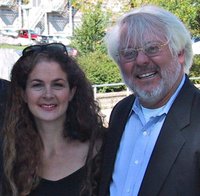
Quick Link
for your convenience!
Human
Rights, Youth Voices etc.
For
Information Concerning the Crisis in Darfur
Whistleblowers
Need Protection

|
|
|
20,000 march in Myanmar against junta
|
20,000 march in Myanmar against junta;
police block monks heading to democracy leader's house
By Associated Press
September 23, 2007
YANGON, Myanmar (AP) - Riot police and barbed wire barricades blocked hundreds of monks and anti-government demonstrators from approaching the home of the detained democracy leader Aung San Suu Kyi on Sunday, in a new show of force against a rising protest movement.
Led by Buddhist monks and joined by nuns, some 20,000 people protested against the junta on Sunday and shouted their support for Suu Kyi, who made her first public appearance in four years on Saturday when a crowd of monks and sympathizers was permitted to pass her house.
On Sunday, a small crowd of about 400 - about half of them monks - split off from the main demonstration and tried to approach Suu Kyi's home again but abandoned the attempt after their path was blocked by riot police and barbed wire barricades.
The monks carried carried a large yellow banner that read: "Love and kindness must win over everything."
The demonstration was the largest since 1988, the year Suu Kyi, the daughter of independence hero Gen. Aung San, took up leadership of a pro-democracy movement. Then, the military fired on peaceful crowds, killing thousands and terrorizing the country.
On Saturday, a group of more than 500 monks and sympathizers walked to Suu Kyi's house, where she greeted them from her gate. One of the monks later said she looked "fit and well."
A photo posted Sunday on several blogs of Myanmar political activists showed her in traditional Myanmar dress in a doorway in the gate to her compound, behind police with riot shields facing the crowd.
The monks on Sunday shouted support for Suu Kyi, while about 10,000 people protected them by forming a human chain along the route. One monk gave a speech Sunday calling for Suu Kyi's release and national reconciliation, the witnesses said, squarely positioning their cause with her long-running struggle for democracy.
By linking their cause to Suu Kyi, who has been detained for about 12 of the last 18 years, the monks increased the pressure on the junta to decide whether to crack down or compromise with the demonstrators.
Plainclothes police trailed the marchers. Some, armed with shotguns, were posted at street corners. Sunday's security presence came after several days of a hands-off attitude by the authorities, who had clearly been trying to avoid provoking the well-disciplined and widely respected monks.
"The Burmese people deserve better," Secretary of State Condoleezza Rice said Sunday. "They deserve a life to be able to live in freedom, just as everyone does. And the brutality of this regime is well known."
David Steinberg, a Myanmar expert at Georgetown University in Washington, said the government's decision to allow the protests to pass Suu Kyi's house on Saturday is a sign "the military is not prepared, unless things get worse, to directly confront the monks in their uniforms."
Steinberg, monitoring events from Singapore, noted that in 1990, the military crushed a protest by hundreds of monks in Mandalay, arresting and defrocking some and closing monasteries linked with the demonstration.
But he said the military remains the country's largest and most powerful institution and its lack of force this time should not be seen as a sign of weakness.
A U.N. official agreed, saying that while Myanmar dissident groups he had met in Bangkok this week were optimistic about the outcome, they failed to take into account the military's history of brutally suppressing uprisings in 1988, 1990 and 1996.
"They were very optimistic and expectant and seemed to believe that there was one outcome possible - which was a popular uprising that brings Suu Kyi to the forefront," said the official, who requested anonymity, citing protocol. "I'm not as confident that is the only outcome possible. I would think massive repression and violence on a significant scale is not to be discounted."
Suu Kyi, 62, is the leader of the National League for Democracy party, which won a 1990 general election but was not allowed to take power by the military. She has been under detention continuously since May 2003.
The protest Sunday, which involved 10,000 monks, began at the famous Shwedagon Pagoda in Myanmar's biggest city, Yangon, and passed the U.S. Embassy among other places, witnesses said.
The current protests were sparked by dissatisfaction with the economy, but have their basis in long pent-up dissatisfaction with the repressive military regime. Using arrests and intimidation, the government had managed to keep demonstrations limited in size and impact until the monks joined.
In the latest expression of international concern over the events, the Secretary-General of the Association of Southeast Asian Nations, of which Myanmar is a member, urged Myanmar officials Sunday to avoid any "strong action" against the protests.
"I hope the relevant authorities in Myanmar will not take any strong action and turn the protests into a big confrontation," ASEAN Secretary-General Ong Keng Yong told The Associated Press by telephone.
|
|
